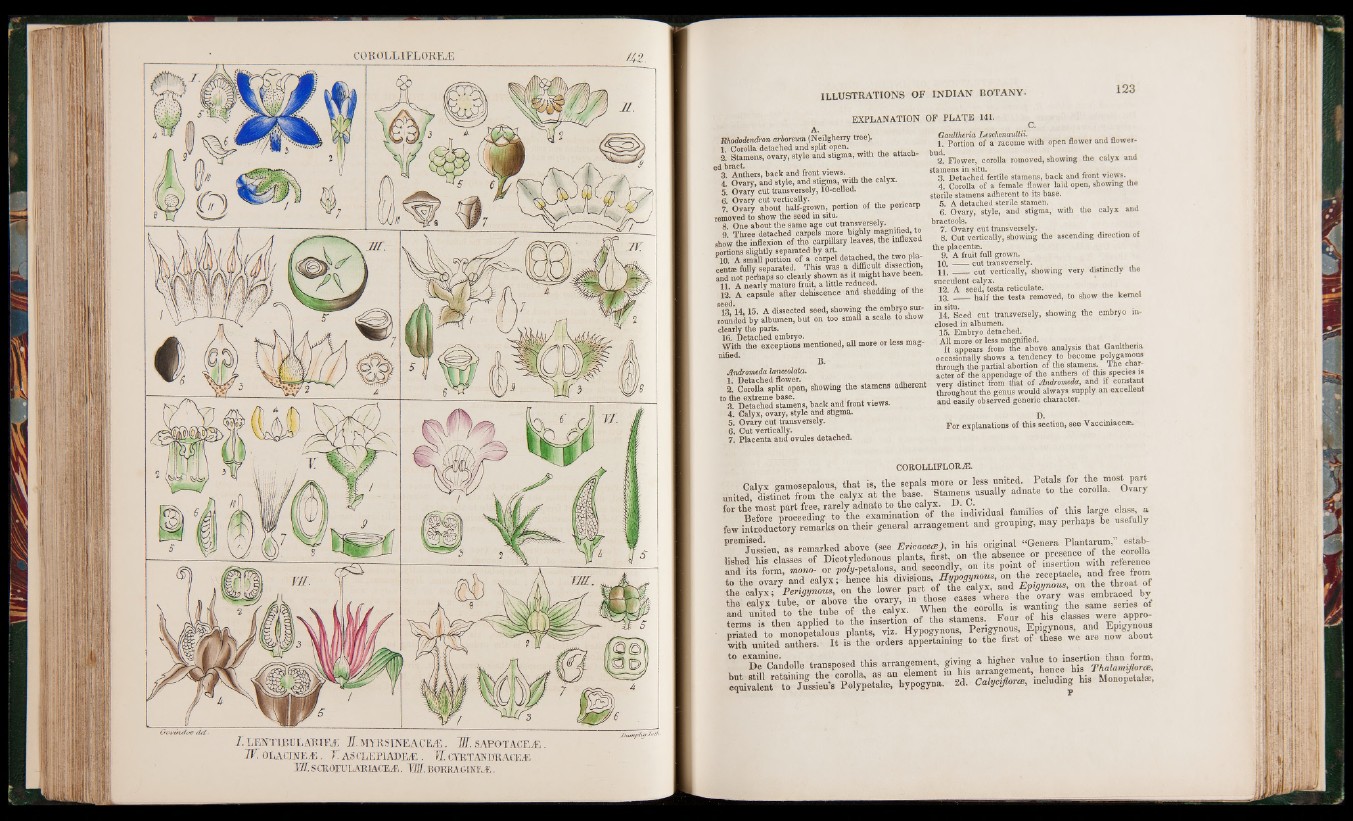
C0K0LL1 FLOTCF.Æ m .
J. LENTIBDLARIEÆ ÏÏ.MY.RSENEACEÆ. If SAFOTA.CEÆ .
IP OLACTNEÆ. T . ASC1VKP1ADEÆ,. JL CYRTABI)KA.CEÆ
JR. S CROFULARIACEiE. UK. BOKRAGIKTÆ.
EXPLANATION OF PLATE 141.
A. C.
Rhododendron arboreum (Neilgherry tree).
1. Corolla detached and split open.
2. Stamens, ovary, style and stigma, with the attached
bract.
3. Anthers, back and front views.
4. Ovary, and style, and stigma, with the calyx.
5*. Ovary cut transversely, 10-celled.
fi. Ovary cut vertically.
7. Ovary about half-grown, portion of the pericarp
removed to show the seed in situ.
8. One about the same age cut transversely.
9. Three detached carpels more highly magnified, to
show the inflexion of the carpillary leaves, the inflexed
portions slightly separated by art. ,
10. A small portion of a carpel detached, the two placentae
ftilly separated. This was a difficult dissection,
and not perhaps so clearly shown as it might have been.
11. A nearly mature fruit, a little reduced.
12. A capsule after dehiscence and sheddmg ot me
813**14,15. A dissected seed, showing the embryo surrounded
by albumen, but on too small a scale to show
clearly the parts.
16. Detached embryo. ,
With the exceptions mentioned, all more or less magnified.
^
Andromeda lanceolata.
1. Detached flower.
2. Corolla split open, showing the stamens adherent
to the extreme base.
3. Detached stamens, back and front views.
4. Calyx, ovary, style and stigma.
5. Ovary cut transversely.
6. Cut vertically.
7. Placenta and ovules detached.
Gaultheria Leschenavdtii.
1. Portion of a raceme with open flower and flowerbud.
. ,
2. Flower, corolla romoved, showing me calyx ana
stamens in situ. ^ .
3. Detached fertile stamens, back and front views.
4. Corolla of a female flower laid open, showing the
sterile stamens adherent to its base.
5. A detached sterile stamen.
6. Ovary, style, and stigma, with the calyx and
bracteols.
7. Ovary cut transversely.
8. Cut vertically, showing the ascending direction ot
the placentae.
9. A fruit full grown.
10. ------ cut transversely. .
1 1 . --------------------- cut vertically, showing very distinctly the
succulent calyx.
12. A seed, testa reticulate.
13. ____half the testa removed, to show the kernel
in situ. . . .
14. Seed cut transversely, showing me embryo inclosed
in albumen.
15. Embryo detached.
All more or less magnified. . , _ ... .
It appears from the above analysis that Gaultheria
occasionally shows a tendency to become polygamous
through the partial abortion of the stamens.; The character
of the appendage of the anthers of this species is
very distinct from that of Andromeda, and if constant
throughout the genus would always supply an excellent
and easily observed generic character.
D.
For explanations of this section, see Vacciniaceaj.
COROLLIFLORiE.
Calyx gamosepalous, that is, the sepals more or less united.
united, distinct from the calyx at the base Stamens usually adnate to the corolla. Ora y
for H i B B I B B f l f l B H I B of thl3 laT t e l few introductory remafks on their general arrangement and grouping, may perhaps b y
and united to the tune oi m 1 j . . -n...,, i«;« classes were appro-
H S S s b ® » = i s =